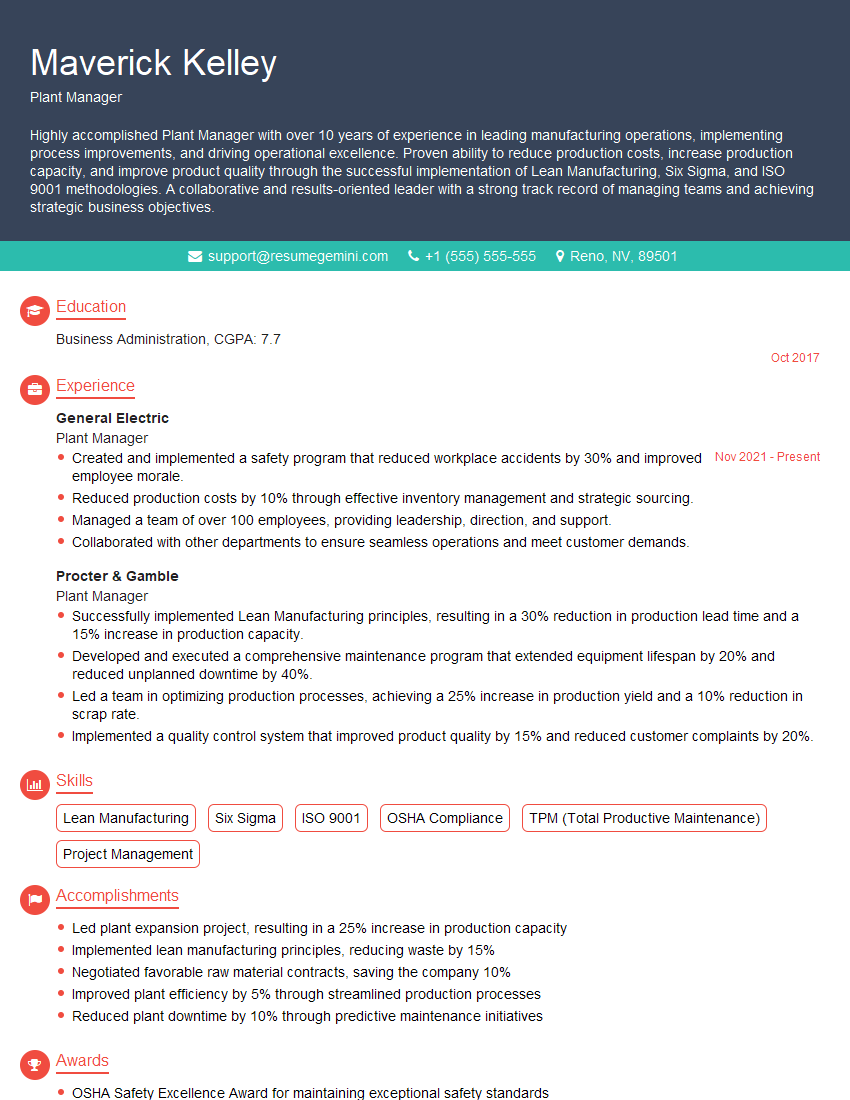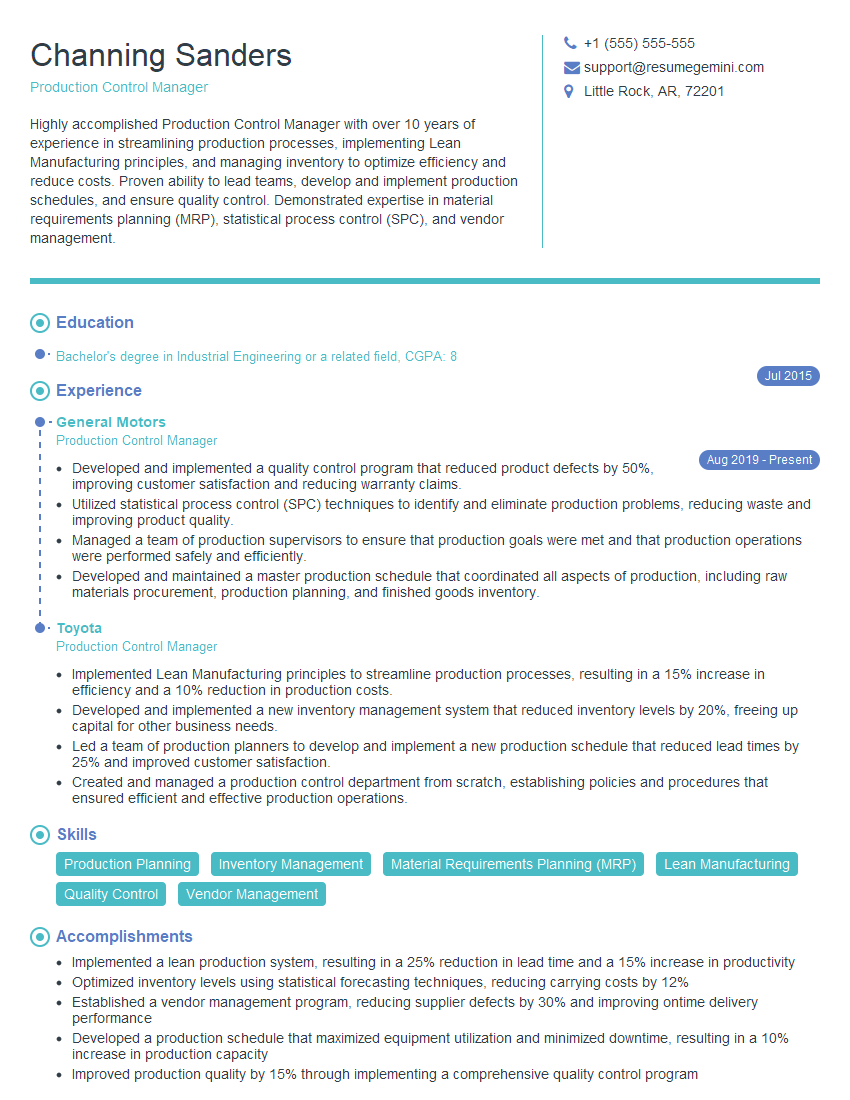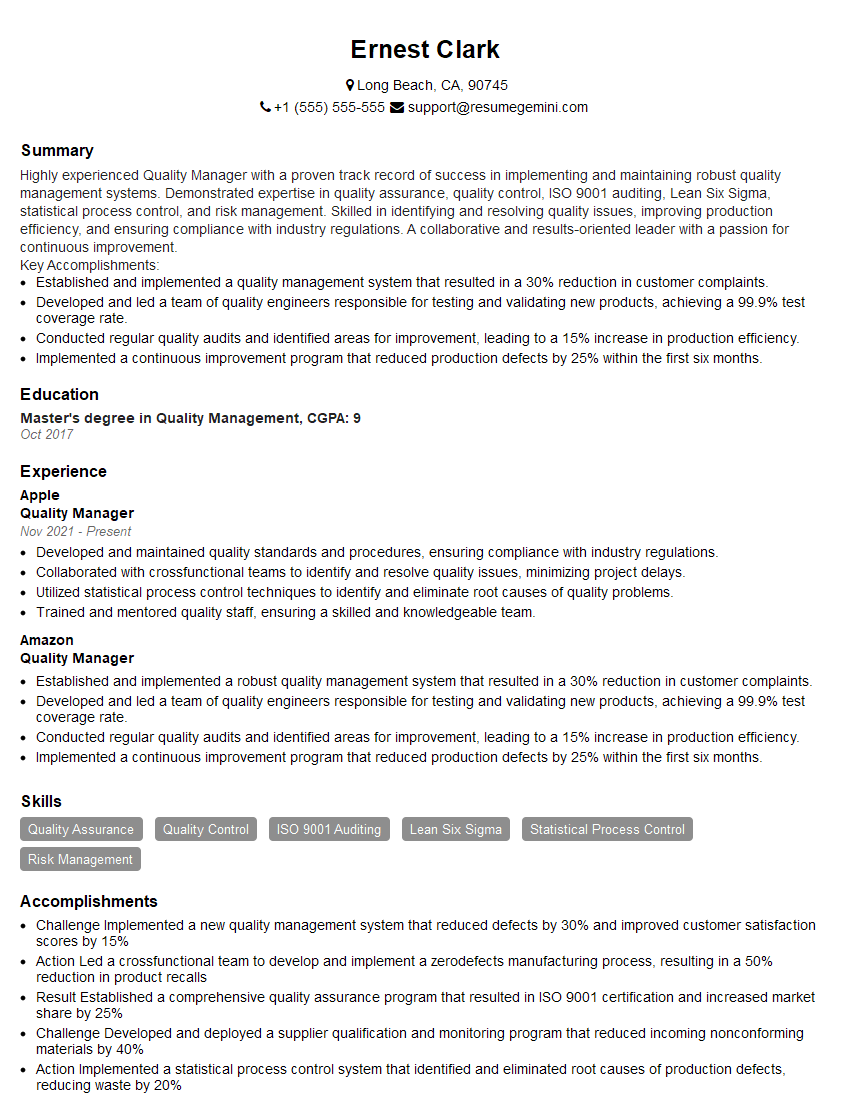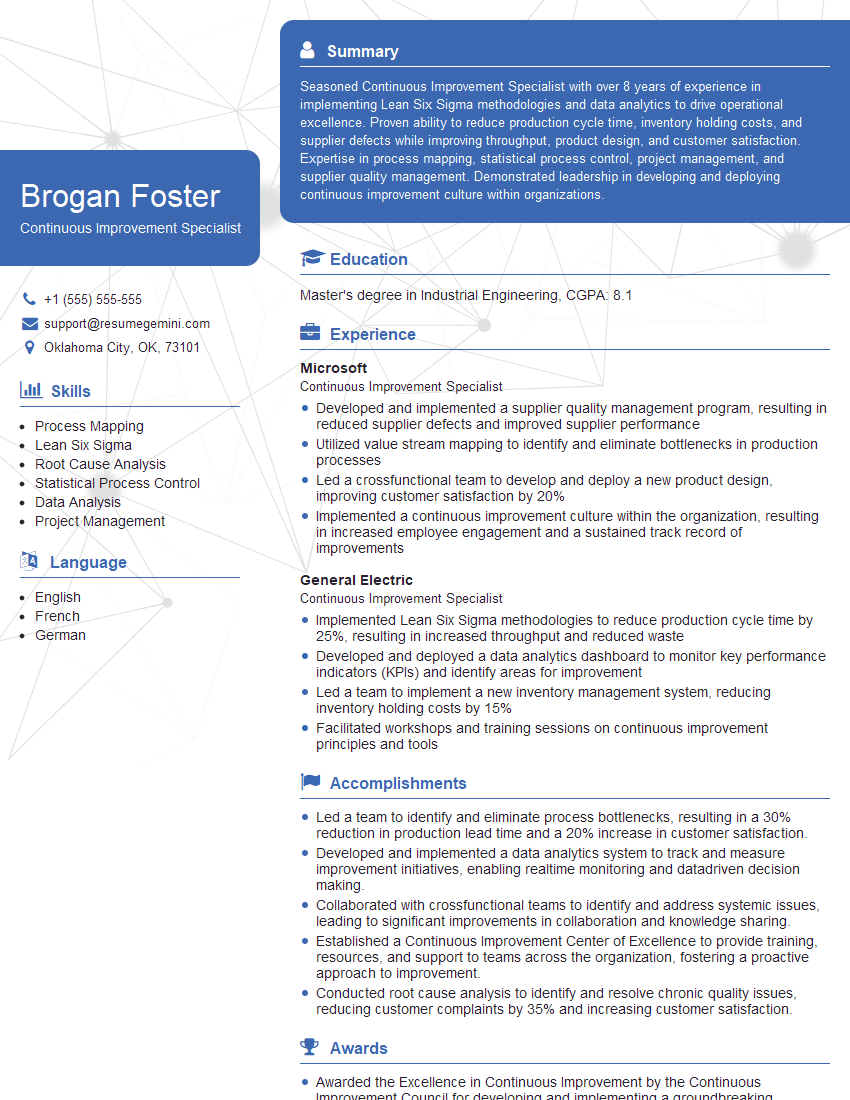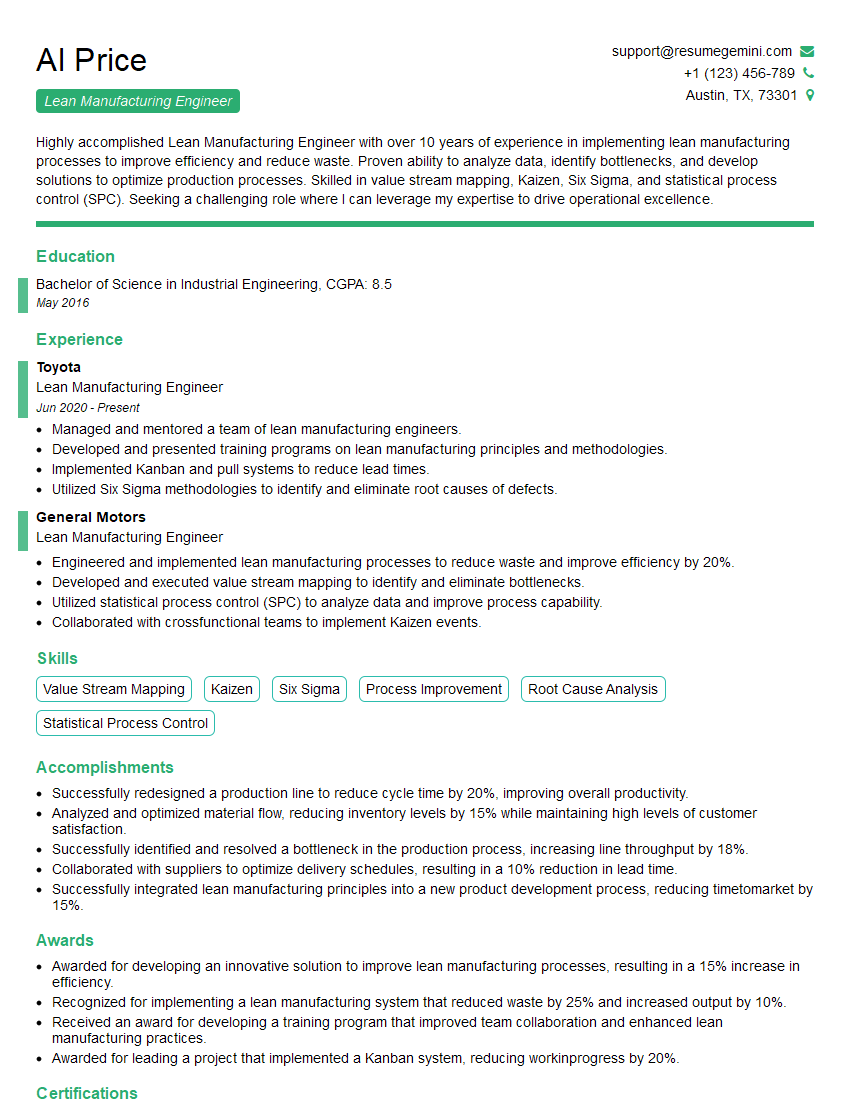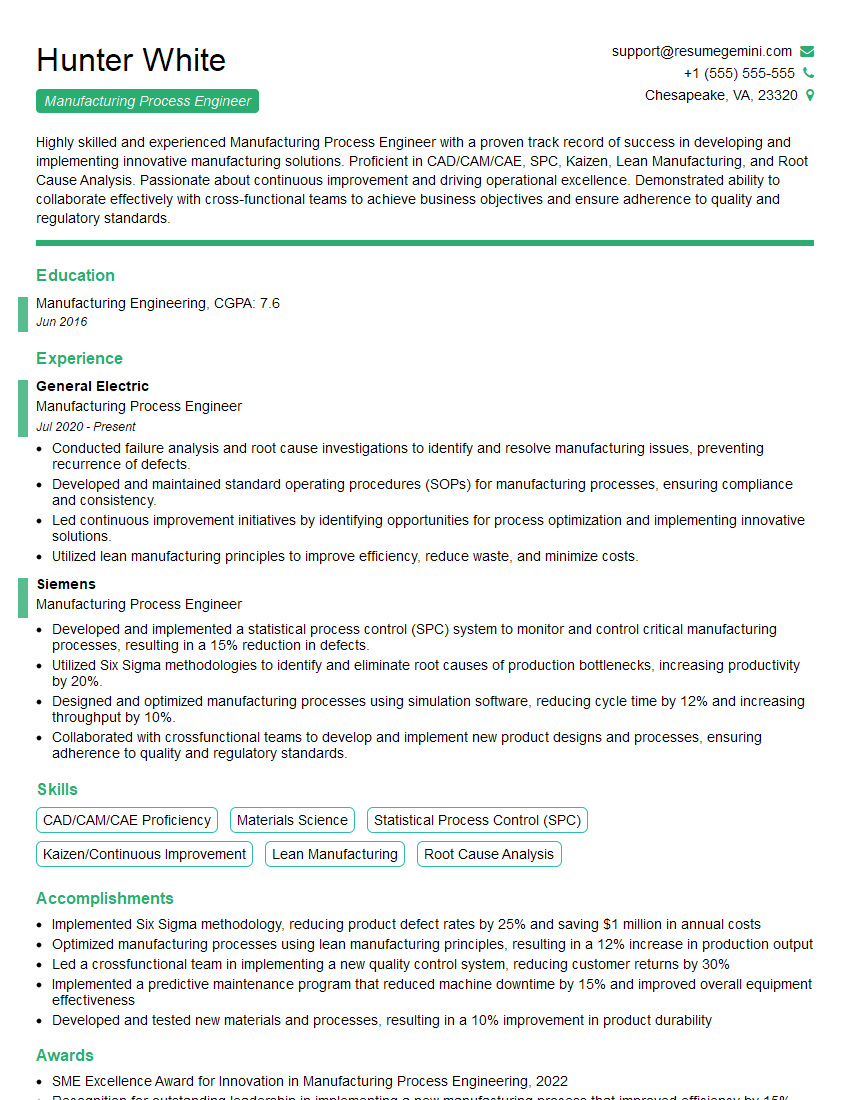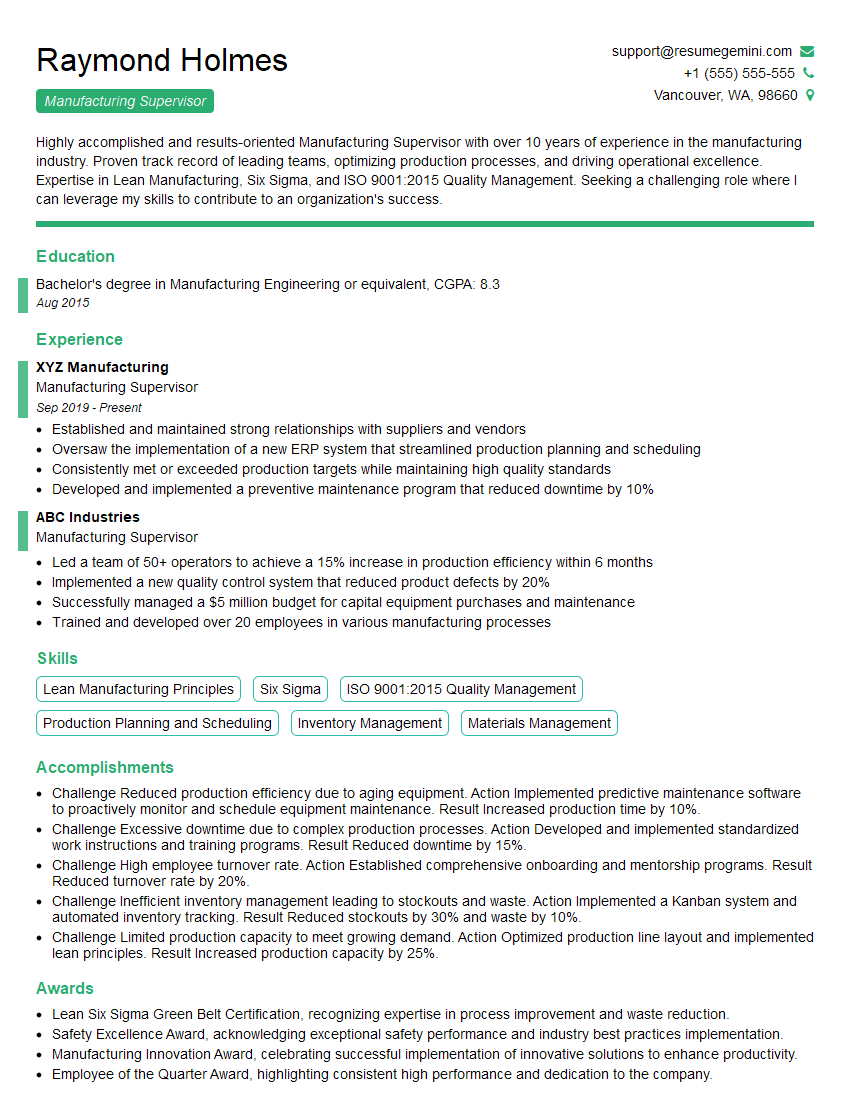Preparation is the key to success in any interview. In this post, we’ll explore crucial Certified Lean Manufacturing Professional (CLMP) interview questions and equip you with strategies to craft impactful answers. Whether you’re a beginner or a pro, these tips will elevate your preparation.
Questions Asked in Certified Lean Manufacturing Professional (CLMP) Interview
Q 1. Define Value Stream Mapping and explain its application in Lean Manufacturing.
Value Stream Mapping (VSM) is a lean manufacturing technique used to visually represent the flow of materials and information required to bring a product or service to the customer. It’s like creating a roadmap of your entire process, highlighting every step, from raw materials to finished goods. This map helps identify bottlenecks, waste, and areas for improvement.
In Lean Manufacturing, VSM is applied to analyze and optimize the entire value stream, not just individual processes. By identifying non-value-added activities (waste), we can streamline the process, reduce lead times, and improve overall efficiency. For example, a VSM might reveal excessive inventory build-up between processes, long transportation times, or unnecessary inspections. Once these bottlenecks are identified, we can implement Kaizen events or other improvement initiatives to eliminate the waste and create a more efficient flow.
Q 2. Explain the 5S methodology and its benefits.
The 5S methodology is a systematic approach to workplace organization that aims to create a clean, orderly, and efficient work environment. The five ‘S’s are:
- Seiri (Sort): Eliminate unnecessary items from the workplace. Think of it as decluttering—removing anything not needed for the current process.
- Seiton (Set in Order): Organize and arrange necessary items for easy access and use. This involves proper storage, labeling, and placement of tools and materials.
- Seiso (Shine): Clean and maintain the workplace. Regular cleaning helps identify potential problems and prevents equipment malfunction.
- Seiketsu (Standardize): Establish standards for maintaining cleanliness and organization. This ensures consistency and prevents backsliding into disorder.
- Shitsuke (Sustain): Maintain the standards and continuously improve the system. This involves regular audits and training to ensure that the 5S practices become ingrained in the workplace culture.
The benefits of 5S include improved safety, reduced waste, increased efficiency, and enhanced productivity. A cleaner, more organized workspace reduces the risk of accidents and improves employee morale.
Q 3. Describe the principles of Kaizen and provide a real-world example.
Kaizen, meaning ‘continuous improvement’ in Japanese, is a philosophy that emphasizes incremental, ongoing improvements in all areas of a business. It’s about small, ongoing changes rather than large-scale projects. The principles of Kaizen include:
- Respect for people: Involving all employees in the improvement process.
- Focus on processes: Improving processes rather than blaming individuals.
- Continuous improvement: Making small, incremental changes over time.
- Data-driven decision-making: Using data to identify areas for improvement.
Real-world example: Imagine a manufacturing plant where workers notice a slight delay in a specific assembly step. Using Kaizen, they might brainstorm and implement a small change like rearranging tools or modifying the workstation layout. This minor adjustment might reduce the assembly time by only a few seconds per unit, but when multiplied across thousands of units produced daily, the cumulative savings in time and resources become significant. This is a practical application of Kaizen – small changes leading to large-scale improvements.
Q 4. How do you identify and eliminate waste in a manufacturing process?
Identifying and eliminating waste is central to Lean Manufacturing. We use a framework known as TIMWOOD to categorize waste:
- Transportation: Unnecessary movement of materials or products.
- Inventory: Excess materials or finished goods.
- Motion: Unnecessary movements of people or equipment.
- Waiting: Idle time for workers, machines, or materials.
- Overproduction: Producing more than needed.
- Over-processing: Performing unnecessary steps or operations.
- Defects: Errors or flaws in products or processes.
To eliminate waste, we need to thoroughly analyze the process using tools like Value Stream Mapping (VSM) and process charts. Once we’ve identified the types of waste present, we can implement solutions, such as implementing pull systems (like Kanban), optimizing layouts, improving process flows, and implementing quality control measures to reduce defects.
Q 5. What are the key performance indicators (KPIs) used to measure Lean improvements?
Key Performance Indicators (KPIs) are crucial for measuring the effectiveness of Lean improvements. Some common KPIs include:
- Lead time: The time it takes to produce a product or service.
- Throughput: The rate at which products or services are produced.
- Inventory levels: The amount of raw materials, work-in-progress, and finished goods.
- Defect rate: The percentage of defective products or services.
- Overall Equipment Effectiveness (OEE): A measure of how effectively equipment is used.
- First Pass Yield: The percentage of products that pass inspection on the first try.
- Cycle Time: The time taken to complete a single process step.
Tracking these KPIs before and after implementing Lean initiatives allows us to quantitatively assess the impact of the improvements.
Q 6. Explain the concept of Kanban and its role in managing workflow.
Kanban is a visual signaling system for managing workflow. It’s like a supermarket shelf; when items are taken, the empty space signals the need for replenishment. In manufacturing, Kanban uses cards or other visual signals to control the flow of materials between different stages of production. This prevents overproduction and ensures that only the needed materials are produced at the right time.
Kanban’s role is to manage workflow by limiting work-in-progress (WIP) and pulling materials through the system as needed. This reduces inventory, improves flow, and helps identify bottlenecks. A Kanban system can be implemented using physical cards, electronic systems, or a combination of both. It promotes a pull system, rather than a push system, preventing overproduction and unnecessary inventory.
Q 7. Describe your experience with implementing Lean principles in a manufacturing environment.
In a previous role at [Company Name], we implemented Lean principles to optimize our assembly line for a key product. We began by conducting a thorough Value Stream Map to identify bottlenecks and areas of waste. This revealed significant delays in material handling and excessive inventory between workstations. We then implemented a Kanban system to control the flow of parts, reducing inventory by 30% and lead time by 15%. Simultaneously, we conducted Kaizen events with the assembly team to streamline individual workstations, further improving efficiency. We tracked KPIs such as lead time, throughput, and defect rate, showing a significant improvement after implementation. The project showcased the effectiveness of integrating Lean principles for enhanced productivity and cost reduction. The employees were also more engaged and motivated by being involved in the improvement process.
Q 8. How do you handle resistance to change during Lean implementation?
Resistance to change is a common hurdle in Lean implementations. It stems from fear of the unknown, loss of control, or perceived threats to job security. Successfully navigating this requires a multi-pronged approach focusing on communication, education, and engagement.
Proactive Communication: Begin by clearly articulating the why behind the Lean initiative. Explain the benefits for the organization and the individual employees. Address concerns head-on and provide transparent updates throughout the process.
Education and Training: Invest in thorough training programs that equip employees with the knowledge and skills necessary to succeed in the new Lean system. This helps reduce uncertainty and empowers employees to participate actively.
Employee Involvement: Include employees in the design and implementation phases. Forming cross-functional teams allows for diverse perspectives and fosters a sense of ownership. Actively soliciting feedback helps address concerns and builds buy-in.
Celebrate Successes: Acknowledge and reward achievements along the way. This reinforces positive behavior and boosts morale, making the transition smoother. Highlight improvements and showcase tangible results.
Address Concerns Empathetically: Listen actively to employees’ concerns and address them respectfully and fairly. A supportive and understanding environment is crucial for overcoming resistance.
For example, in a previous project, we faced resistance from machine operators who were hesitant to adopt new standardized work instructions. We addressed this by involving them in the development of the new instructions, actively seeking their input and expertise. This not only led to more effective instructions but also fostered a sense of ownership and buy-in, leading to a smooth transition.
Q 9. Explain the difference between pull and push systems in manufacturing.
The core difference between pull and push systems lies in how materials flow through the production process. In a push system, production is based on forecasts or schedules. Materials are pushed through the process whether or not there’s immediate demand. This often leads to excess inventory, wasted resources, and longer lead times.
In contrast, a pull system, like Kanban, only produces what’s needed, when it’s needed. Production is triggered by actual customer demand. This minimizes waste, reduces inventory, and improves responsiveness to customer needs.
Imagine a restaurant. A push system is like preparing all the dishes in advance, hoping they’ll sell. Many might go to waste. A pull system is like preparing dishes only when a customer orders them, ensuring freshness and minimizing waste. Lean manufacturing emphasizes pull systems for their efficiency and responsiveness.
Q 10. What are the benefits of using a standardized work process?
Standardized work (SW) documents the best-known method for performing a specific task. It ensures consistency, reduces errors, and improves efficiency. The benefits extend beyond just operational improvements:
Improved Quality: By standardizing processes, you reduce variability and the likelihood of defects. It creates a consistent outcome every time.
Increased Efficiency: SW eliminates unnecessary steps and movements, optimizing the workflow. This reduces cycle times and increases productivity.
Enhanced Safety: Standardized procedures often incorporate safety protocols, reducing the risk of workplace accidents.
Easier Training: New employees can learn the correct methods quickly and easily using standardized work instructions.
Improved Problem Solving: Any deviation from the standard immediately highlights a potential issue, facilitating timely problem-solving.
For instance, in a packaging line, standardized work can define the exact sequence of actions, the proper tools, and the expected cycle time for each operator. This ensures consistency in packaging quality and speed, minimizing errors and maximizing output.
Q 11. Describe your experience with root cause analysis techniques (e.g., 5 Whys, Fishbone Diagram).
Root cause analysis is critical in Lean to prevent recurring problems. I’m proficient in several techniques, including the 5 Whys and the Fishbone diagram (Ishikawa diagram).
5 Whys: This iterative technique involves repeatedly asking ‘Why?’ to drill down to the root cause of a problem. It’s simple yet effective for identifying the underlying issues.
Example: A machine keeps breaking down.
Why? Because a component is wearing out.
Why? Because it’s not properly lubricated.
Why? Because the lubrication schedule isn’t followed.
Why? Because the schedule isn’t visible to the operator.
Why? Because it wasn’t properly communicated.Fishbone Diagram: This visual tool helps organize potential causes of a problem, categorized by categories like people, methods, materials, machines, environment, and measurement. It’s helpful for brainstorming and collaboratively identifying root causes.
In a previous project, we used the 5 Whys to investigate frequent customer complaints about late deliveries. Through iterative questioning, we uncovered a root cause in inefficient scheduling practices within our logistics department.
Q 12. How do you measure the effectiveness of a Lean initiative?
Measuring the effectiveness of a Lean initiative requires a multifaceted approach using both qualitative and quantitative metrics. The specific metrics will depend on the specific goals of the initiative.
Lead Time Reduction: Track the time it takes to complete a process from start to finish.
Cycle Time Reduction: Measure the time it takes to process a single unit.
Inventory Reduction: Monitor the levels of work-in-progress (WIP) and finished goods inventory.
Defect Rate Reduction: Track the number of defects per unit or per batch.
Overall Equipment Effectiveness (OEE): A comprehensive metric encompassing availability, performance, and quality rate.
Employee Engagement and Satisfaction: Collect feedback through surveys and observations.
It’s crucial to establish baseline metrics before implementing the initiative to accurately measure improvements. Regular monitoring and analysis are necessary to track progress and make adjustments as needed.
Q 13. Explain the concept of Total Productive Maintenance (TPM).
Total Productive Maintenance (TPM) is a proactive maintenance strategy aimed at maximizing equipment effectiveness and minimizing downtime. It involves engaging all employees, not just maintenance personnel, in equipment maintenance and improvement. Key aspects include:
Autonomous Maintenance: Empowering operators to perform basic maintenance tasks on their own machines, fostering ownership and reducing downtime.
Planned Maintenance: Implementing a systematic schedule for preventive maintenance to prevent equipment failures.
Focused Improvement: Using data and analysis to identify and address recurring equipment problems.
Early Equipment Management: Involving maintenance in the design and procurement of new equipment.
Training and Education: Providing comprehensive training to all employees on maintenance procedures and best practices.
TPM creates a culture of proactive maintenance where everyone is responsible for equipment health, leading to reduced downtime, improved quality, and increased production efficiency.
Q 14. What is the role of visual management in a Lean environment?
Visual management is a cornerstone of Lean, using visual cues to communicate information quickly and effectively. It makes key performance indicators (KPIs) readily apparent, facilitating immediate action and problem-solving. Examples include:
Kanban boards: Visually represent the flow of work and identify bottlenecks.
Andon cords: Allow operators to quickly signal problems that need immediate attention.
Visual displays of KPIs: Use charts and graphs to show production metrics, quality levels, and safety records.
5S workplace organization: Create a clean, organized, and efficient workspace.
Shadow boards: Clearly indicate where tools should be stored.
Visual management reduces reliance on paperwork and improves communication, making it easier for everyone to understand the current state and identify areas for improvement. It fosters a culture of transparency and accountability.
Q 15. How do you prioritize improvement projects in a Lean manufacturing setting?
Prioritizing improvement projects in Lean manufacturing relies on a systematic approach that balances urgency, impact, and feasibility. We often use a prioritization matrix, like a weighted scoring system, considering factors such as the potential cost savings, impact on customer satisfaction, safety improvements, and the effort required for implementation. For instance, a project with high cost savings and minimal implementation effort would score high and be prioritized. We also consider the urgency – a project causing safety concerns or significant customer complaints might move to the top regardless of its long-term cost-savings potential. The selection process involves a cross-functional team, including shop floor personnel, engineers, and management, ensuring diverse perspectives and buy-in. Finally, we always start with a clear understanding of the current state, using value stream mapping to pinpoint bottlenecks and areas with the greatest potential for improvement. This ensures we tackle the projects with the most significant impact.
Career Expert Tips:
- Ace those interviews! Prepare effectively by reviewing the Top 50 Most Common Interview Questions on ResumeGemini.
- Navigate your job search with confidence! Explore a wide range of Career Tips on ResumeGemini. Learn about common challenges and recommendations to overcome them.
- Craft the perfect resume! Master the Art of Resume Writing with ResumeGemini’s guide. Showcase your unique qualifications and achievements effectively.
- Don’t miss out on holiday savings! Build your dream resume with ResumeGemini’s ATS optimized templates.
Q 16. Describe your experience with using Poka-Yoke (error-proofing) techniques.
Poka-Yoke, or error-proofing, is crucial for building quality into the process rather than inspecting it out. In a previous role, we implemented Poka-Yoke in an assembly line where incorrect component placement was a frequent issue. We introduced a simple color-coding system for parts and redesigned the fixture to only accept the correctly colored components. This simple change dramatically reduced errors by preventing the wrong part from even fitting into place. In another instance, we used a limit switch to prevent a machine from operating if a safety guard was open. These are examples of simple yet effective Poka-Yoke techniques that can prevent defects from occurring in the first place, thus saving time, resources, and improving product quality. A key to successful Poka-Yoke implementation is involving the operators in the design process. Their on-the-ground experience and feedback ensure that the error-proofing measures are both effective and practical.
Q 17. What are some common barriers to successful Lean implementation?
Several obstacles hinder successful Lean implementation. Lack of top management commitment is a major one – Lean requires a fundamental shift in organizational culture and requires sustained leadership support. Resistance to change from employees, fearing job security or unfamiliar processes, is another significant barrier. Insufficient training and development can leave employees unsure of how to apply Lean tools and principles effectively. Inadequate data collection and analysis also pose a problem as it prevents identification of root causes and the impact of improvement initiatives. Finally, a lack of clearly defined goals and metrics can lead to diffuse efforts and the inability to measure success. Addressing these barriers requires careful planning, open communication, strong leadership, and a gradual, iterative approach to change.
Q 18. How do you ensure employee buy-in and engagement during Lean transformation?
Ensuring employee buy-in is paramount. We start by clearly communicating the goals and benefits of Lean – how it will benefit both the company and the employees themselves (e.g., improved work environment, increased job satisfaction, less wasted effort). We actively involve employees in the improvement process – their insights and expertise are invaluable. This includes using Kaizen events, where cross-functional teams work together to solve problems. Training and education are crucial, equipping employees with the knowledge and skills necessary to utilize Lean tools effectively. We also foster a culture of open communication, providing opportunities for feedback and addressing concerns promptly. Celebrating successes, both big and small, reinforces positive behavior and motivates further engagement. Ultimately, making employees active participants rather than passive recipients of change is critical for successful Lean transformation.
Q 19. What is your understanding of Gemba walks and their importance?
Gemba walks are structured observations of the actual work process in its natural environment – the Gemba. They are not casual walkthroughs, but rather a systematic way to identify problems, gather data, and understand the flow of materials and information. During a Gemba walk, I look for bottlenecks, waste (muda), safety hazards, and opportunities for improvement. The key is to observe, ask questions, and engage with the people directly involved in the process. This firsthand experience provides valuable insights that are often missed in meetings or reports. Gemba walks are important because they provide a direct, real-time understanding of the process, helping to identify areas for immediate improvement and inform longer-term strategies. They also demonstrate leadership’s commitment to understanding the challenges faced by shop floor workers, fostering a sense of collaboration and respect.
Q 20. Describe your experience with using data analysis to drive Lean improvements.
Data analysis is essential for driving continuous improvement. In past projects, I’ve used statistical process control (SPC) charts to monitor process variability and identify sources of defects. We’ve also employed value stream mapping to visualize the flow of materials and identify waste. This allowed us to pinpoint areas where lead times were excessive or where defects were concentrated. We used this data to prioritize improvement projects and measure the effectiveness of interventions. For instance, analyzing cycle times revealed a bottleneck in a particular machine, prompting us to invest in preventative maintenance and operator training, resulting in a significant reduction in downtime. The key is to collect relevant data, analyze it objectively, and use the insights gained to inform decision-making and drive continuous improvement. Data visualization tools, such as dashboards and charts, are essential to make the findings easily understandable to a broader audience.
Q 21. How do you communicate Lean concepts effectively to different stakeholders?
Effective communication is key to Lean implementation. Different stakeholders require tailored approaches. For senior management, I focus on the strategic benefits – cost savings, increased efficiency, and competitive advantage. For shop floor workers, I emphasize the practical improvements – less wasted time, safer working conditions, and more engaging work. We use visual aids, such as value stream maps and charts, to illustrate complex concepts in a simple, easily understandable manner. Regular updates and progress reports keep stakeholders informed and engaged. We also use story-telling to make Lean principles more relatable and memorable, sharing success stories and illustrating the positive impact on the business and employees. Finally, I focus on active listening and feedback mechanisms to ensure everyone feels heard and involved in the process.
Q 22. Explain your understanding of the value chain and how it relates to Lean principles.
The value chain is a sequence of activities that add value to a product or service, from raw materials to delivery to the customer. In Lean manufacturing, we analyze the value chain to identify and eliminate waste (muda) at every stage. This is crucial because Lean’s core principle is to maximize value for the customer while minimizing waste.
Think of it like baking a cake. The value chain includes sourcing ingredients, mixing the batter, baking, cooling, frosting, and finally, delivering it to the customer. Lean would examine each step to see if there are unnecessary actions, delays, or defects that don’t contribute to customer satisfaction. For example, if we are waiting too long for ingredients or if we are baking more cakes than ordered, we are wasting time, resources and money. Lean principles help streamline this process to maximize efficiency and minimize waste at every step.
- Identifying Value: Determining what activities truly add value from the customer’s perspective.
- Mapping the Value Stream: Visually representing all steps in the process, including both value-added and non-value-added activities.
- Flow Optimization: Improving the flow of materials and information to eliminate bottlenecks and reduce lead times.
- Waste Reduction: Targeting and eliminating seven types of waste (muda): Transportation, Inventory, Motion, Waiting, Overproduction, Over-processing, and Defects.
Q 23. Describe a situation where you had to solve a complex manufacturing problem using Lean tools and techniques.
In my previous role at a medical device manufacturer, we faced a significant bottleneck in our assembly line, leading to long lead times and increased inventory costs. Production was not meeting demand, resulting in unsatisfied customers. Using Lean tools, we tackled the problem systematically:
- Value Stream Mapping (VSM): We created a VSM to visualize the entire assembly process, identifying all steps, material flow, and time spent at each station. This revealed that a specific assembly step was the major bottleneck, causing significant waiting time for subsequent steps.
- 5 Whys Analysis: We used the 5 Whys technique to understand the root cause of the bottleneck. It turned out to be an outdated assembly tool that was inefficient and prone to errors, causing frequent stoppages and rework.
- Kaizen Event: We held a Kaizen event, involving team members from different departments. During this focused event, we brainstormed solutions, experimented with improved assembly techniques, and ultimately selected a more efficient and ergonomic tool.
- Implementation and Monitoring: We implemented the new tool and closely monitored the process using control charts to ensure the improvements were sustained. This resulted in a 20% reduction in lead time and a significant decrease in work-in-progress (WIP) inventory.
This experience highlighted the power of Lean tools in identifying and resolving complex manufacturing problems through a data-driven and collaborative approach.
Q 24. What are the key differences between Lean and Six Sigma methodologies?
While both Lean and Six Sigma aim to improve efficiency and quality, they have different focuses:
- Lean focuses on eliminating waste and maximizing value from the customer’s perspective. It’s a holistic approach that considers the entire process. Think of Lean as streamlining the entire process, removing any unneeded steps, so you’re doing only what adds value.
- Six Sigma emphasizes reducing variation and defects to achieve near-perfect quality. It uses statistical tools to identify and eliminate root causes of defects. Think of Six Sigma as precision – making sure what you *do* do is done with extremely high quality and consistent results.
In essence: Lean is about doing the right things, while Six Sigma is about doing things right. They are often complementary and can be used together for enhanced results. For example, Lean might identify a wasteful process, and Six Sigma could then be used to improve the quality of the remaining process.
Q 25. How do you ensure the sustainability of Lean improvements over time?
Sustainability of Lean improvements requires a strong culture of continuous improvement and a commitment from all levels of the organization. Here are key strategies:
- Leadership Engagement: Visible and active support from leadership is crucial. Leaders must champion Lean principles and create an environment where employees feel empowered to identify and implement improvements.
- Standardized Work: Clearly defined and documented standard work procedures ensure consistency and reduce variation, preventing backsliding into old habits.
- Visual Management: Using visual tools like Kanban boards, 5S methodologies, and performance dashboards helps monitor progress, identifies deviations, and promotes transparency.
- Training and Development: Ongoing training ensures that employees understand and utilize Lean tools and techniques effectively. This includes training on problem-solving techniques like root cause analysis and continuous improvement.
- Regular Reviews and Kaizen Events: Regularly scheduled reviews and periodic Kaizen events allow for continuous improvement and address emerging challenges proactively.
- Performance Measurement: Tracking key performance indicators (KPIs) linked to Lean goals provides data-driven insights, allowing for adjustments and improvements. This ensures continuous monitoring and improvement and helps demonstrate success in a tangible manner.
Essentially, the key to long-term success is building a culture where continuous improvement is ingrained in the organization’s DNA, and everyone participates actively in maintaining gains.
Q 26. What are your strengths and weaknesses in relation to Lean Manufacturing principles?
Strengths: My strengths lie in my ability to quickly understand complex manufacturing processes, identify waste, and implement effective Lean solutions. I have a proven track record of success in leading Kaizen events, facilitating process improvements, and training team members on Lean principles. I’m adept at using data analysis to support decision-making and ensure the effectiveness of implemented changes. I’m also comfortable working across different departments and levels of the organization to build consensus and drive improvement.
Weaknesses: While I have strong analytical skills, I occasionally need to improve my communication skills to ensure that complex Lean concepts are easily understood by all stakeholders, particularly those unfamiliar with Lean methodologies. I also aim to further develop my expertise in advanced Lean simulation tools to enhance my predictive capabilities.
Q 27. Describe your experience with Lean software and tools (e.g., ERP, MES).
I have extensive experience working with various Lean software and tools. This includes Enterprise Resource Planning (ERP) systems such as SAP and Oracle, Manufacturing Execution Systems (MES) such as Rockwell Automation FactoryTalk, and specialized Lean software for Value Stream Mapping and Kanban management. My experience with these systems involves not only their use but also configuration and optimization to support Lean initiatives. For example, I have worked to integrate MES systems with ERP systems to improve data flow and reduce reporting delays, and also configured Kanban software to support pull systems, improving inventory management.
I understand how to leverage the data captured within these systems to track key performance indicators and to identify areas for improvement. My focus is always on extracting actionable insights from data to drive more effective continuous improvement activities.
Q 28. How do you stay current with the latest trends and developments in Lean Manufacturing?
Staying current in the ever-evolving field of Lean Manufacturing is crucial. I employ several methods to achieve this:
- Professional Associations: Active membership in organizations like the Association for Manufacturing Excellence (AME) allows access to industry best practices, publications, and networking opportunities with other Lean professionals.
- Conferences and Workshops: I regularly attend industry conferences and workshops to learn about the latest trends, tools, and techniques. This provides direct exposure to new ideas and best practice implementations.
- Industry Publications and Journals: Following leading publications in the Lean and manufacturing fields keeps me informed of the latest research and real-world applications.
- Online Courses and Webinars: Utilizing various online platforms offers access to a wide range of training materials and updates on Lean methodologies.
- Networking: Building a network of Lean professionals through online forums and in-person events facilitates the exchange of ideas and knowledge sharing.
By combining these approaches, I ensure that my knowledge remains up-to-date and relevant, allowing me to adapt my Lean methodologies and approaches to continually optimize processes and results.
Key Topics to Learn for Certified Lean Manufacturing Professional (CLMP) Interview
Preparing for your CLMP interview requires a strong understanding of both the theoretical underpinnings and practical applications of Lean Manufacturing principles. Focus your studies on these key areas to showcase your expertise and confidently navigate the interview process.
- Lean Thinking Principles: Understand the core philosophies of Lean, including value stream mapping, waste elimination (Muda), and continuous improvement (Kaizen). Be prepared to discuss how these principles interrelate and their practical impact on manufacturing efficiency.
- Value Stream Mapping (VSM): Master the creation and analysis of VSMs. Practice identifying bottlenecks, waste, and areas for improvement within a manufacturing process. Be ready to explain your approach to VSM implementation and its contribution to process optimization.
- 5S Methodology: Demonstrate a clear understanding of 5S (Sort, Set in Order, Shine, Standardize, Sustain) and its application in creating a more efficient and organized work environment. Be ready to provide examples of successful 5S implementations and the quantifiable results achieved.
- Kaizen Events and Rapid Improvement: Explain your understanding of Kaizen events and how they facilitate rapid process improvement. Be prepared to discuss your experience with facilitating or participating in such events, highlighting your problem-solving skills and collaborative approach.
- Lean Metrics and Measurement: Discuss key performance indicators (KPIs) used in Lean manufacturing, such as Overall Equipment Effectiveness (OEE), Takt Time, and lead time. Be ready to explain how these metrics are used to track progress and identify areas needing improvement.
- Problem-Solving Methodologies (e.g., A3 Reporting, 8D): Familiarize yourself with structured problem-solving methodologies commonly used in Lean environments. Demonstrate your ability to systematically approach and solve manufacturing challenges.
- Implementing Lean in Different Manufacturing Settings: Be prepared to discuss how Lean principles can be adapted and implemented across various manufacturing environments, considering factors like scale, product complexity, and industry specifics.
Next Steps
Mastering the Certified Lean Manufacturing Professional (CLMP) principles significantly enhances your career prospects, opening doors to leadership roles and higher earning potential within the manufacturing industry. To maximize your chances of landing your dream job, a well-crafted, ATS-friendly resume is crucial. ResumeGemini is a trusted resource that can help you create a professional and impactful resume that highlights your CLMP skills and experience. ResumeGemini provides examples of resumes tailored to Certified Lean Manufacturing Professional (CLMP) candidates – take advantage of these valuable resources to present yourself effectively to potential employers.
Explore more articles
Users Rating of Our Blogs
Share Your Experience
We value your feedback! Please rate our content and share your thoughts (optional).
What Readers Say About Our Blog
Hello,
We found issues with your domain’s email setup that may be sending your messages to spam or blocking them completely. InboxShield Mini shows you how to fix it in minutes — no tech skills required.
Scan your domain now for details: https://inboxshield-mini.com/
— Adam @ InboxShield Mini
Reply STOP to unsubscribe
Hi, are you owner of interviewgemini.com? What if I told you I could help you find extra time in your schedule, reconnect with leads you didn’t even realize you missed, and bring in more “I want to work with you” conversations, without increasing your ad spend or hiring a full-time employee?
All with a flexible, budget-friendly service that could easily pay for itself. Sounds good?
Would it be nice to jump on a quick 10-minute call so I can show you exactly how we make this work?
Best,
Hapei
Marketing Director
Hey, I know you’re the owner of interviewgemini.com. I’ll be quick.
Fundraising for your business is tough and time-consuming. We make it easier by guaranteeing two private investor meetings each month, for six months. No demos, no pitch events – just direct introductions to active investors matched to your startup.
If youR17;re raising, this could help you build real momentum. Want me to send more info?
Hi, I represent an SEO company that specialises in getting you AI citations and higher rankings on Google. I’d like to offer you a 100% free SEO audit for your website. Would you be interested?
Hi, I represent an SEO company that specialises in getting you AI citations and higher rankings on Google. I’d like to offer you a 100% free SEO audit for your website. Would you be interested?
good

